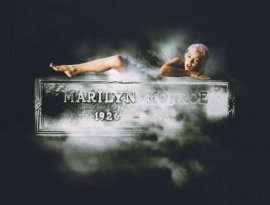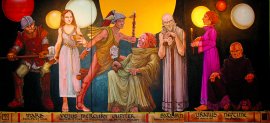 On
a small, dark stage, Venus slowly materializes, walking silently
toward us in a diaphanous robe, holding a chalice and a sheath of
wheat, her eyes distant. Jupiter, looking like Dionysus, sits on an
invisible chair holding a jester's toy, laughing at something he's
just heard from sly Mercury, who slowly floats by. Neptune the mystic
crouches, bare-headed, waiting, looking beyond us.
On
a small, dark stage, Venus slowly materializes, walking silently
toward us in a diaphanous robe, holding a chalice and a sheath of
wheat, her eyes distant. Jupiter, looking like Dionysus, sits on an
invisible chair holding a jester's toy, laughing at something he's
just heard from sly Mercury, who slowly floats by. Neptune the mystic
crouches, bare-headed, waiting, looking beyond us.

 A
huge foam cornucopia, curling in a massive yellowish shape, fills up
the entire front window of the Leger Gallery in its current exhibit.
Instead of the smooth perfect curve of a mathematical spiral, we have
an unevenly textured solidified liquid used in a completely new way
to describe the flow of thought and time and nature. With an
industrial material normally used to insulate houses, Terry Rathje
has created a buoyant example of the lively and inventive
presentation inside.
A
huge foam cornucopia, curling in a massive yellowish shape, fills up
the entire front window of the Leger Gallery in its current exhibit.
Instead of the smooth perfect curve of a mathematical spiral, we have
an unevenly textured solidified liquid used in a completely new way
to describe the flow of thought and time and nature. With an
industrial material normally used to insulate houses, Terry Rathje
has created a buoyant example of the lively and inventive
presentation inside.
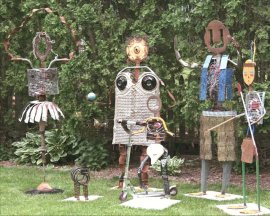 The use of found objects carries an up-front challenge to artists. Do you try to transform the identity of the "junk" by visually turning it into something else? Or do you accept the object (and all of its cultural baggage) for what it is and shape your artistic statement to incorporate the materials and their recognizability?
The use of found objects carries an up-front challenge to artists. Do you try to transform the identity of the "junk" by visually turning it into something else? Or do you accept the object (and all of its cultural baggage) for what it is and shape your artistic statement to incorporate the materials and their recognizability?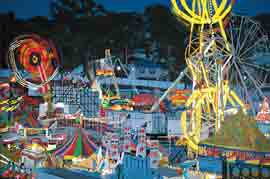 Iowa
Pastimes, Thomas C.
Jackson's current exhibit of paintings at the Figge Art Museum, is
filled with vivid observations of two American institutions filtered
through the single eye of the artist's camera. Both worlds -
political conventions and the Iowa State Fair - are spectaculars
with bright lights, designed to generate excitement and movement, and
they make their appeals to the great cross section of America.
Iowa
Pastimes, Thomas C.
Jackson's current exhibit of paintings at the Figge Art Museum, is
filled with vivid observations of two American institutions filtered
through the single eye of the artist's camera. Both worlds -
political conventions and the Iowa State Fair - are spectaculars
with bright lights, designed to generate excitement and movement, and
they make their appeals to the great cross section of America.
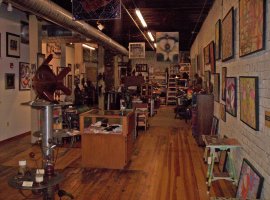 When it comes to art, most artists will tell you that the excitement, or the magic, actually happens during the creative process. And that usually happens in the studio.
When it comes to art, most artists will tell you that the excitement, or the magic, actually happens during the creative process. And that usually happens in the studio.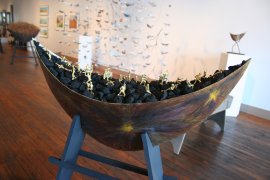 In
the new exhibit at Quad City Arts, the concept of the private journey
is illustrated by two artists. But by showing only the means
of literal transportation - vessels and roads - the artists
create something universal to help us consider our own spiritual
travels.
In
the new exhibit at Quad City Arts, the concept of the private journey
is illustrated by two artists. But by showing only the means
of literal transportation - vessels and roads - the artists
create something universal to help us consider our own spiritual
travels.
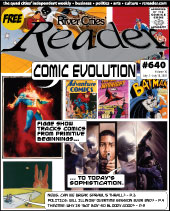
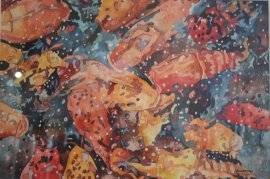 Artists
Ralph Iaccarino and Silvia Engel are wonderfully matched in an
attractive show at the MidCoast Fine Arts Gallery at the Mississippi
Valley Welcome Center in LeClaire. Iaccarino paints light and musical
colors in a flat space, while Engel works in a shallow space with
luminescent three-dimensional colors.
Artists
Ralph Iaccarino and Silvia Engel are wonderfully matched in an
attractive show at the MidCoast Fine Arts Gallery at the Mississippi
Valley Welcome Center in LeClaire. Iaccarino paints light and musical
colors in a flat space, while Engel works in a shallow space with
luminescent three-dimensional colors.
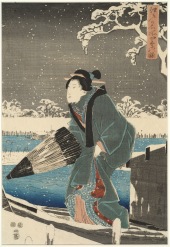 Roughly
150 years ago in Europe, Impressionist and young Post- Impressionist
artists were first delighting in the ukiyo-e,
wood-block prints from Japan.
Roughly
150 years ago in Europe, Impressionist and young Post- Impressionist
artists were first delighting in the ukiyo-e,
wood-block prints from Japan.
